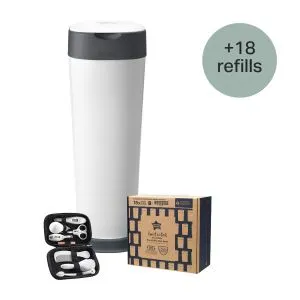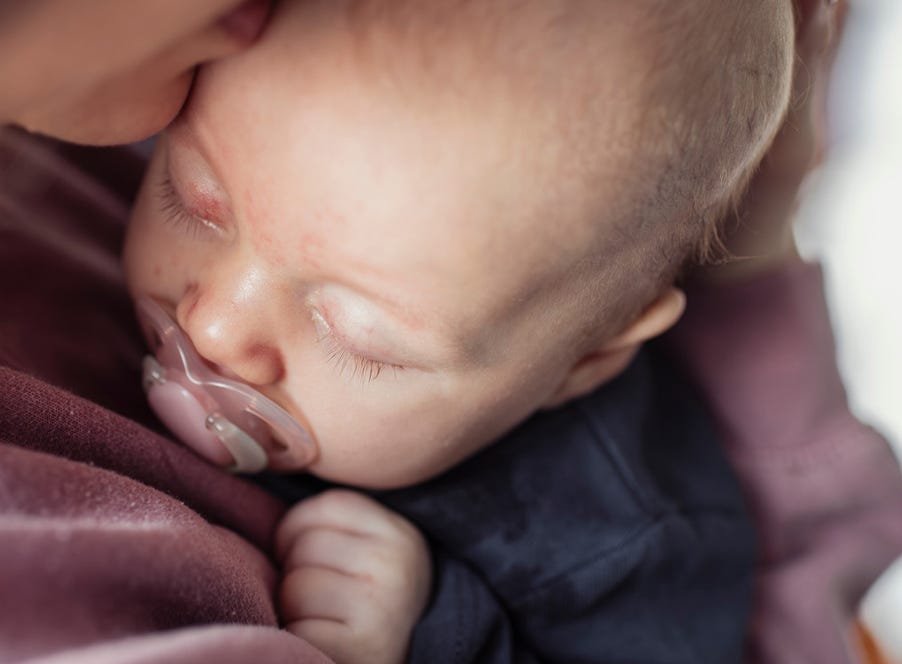
Ultimate XL Nappy Disposal Bundle with 18 Refills
Bundle & Save 40%
Subscription orders can be cancelled at anytime. Free delivery on all subsequent subscription orders. Find out more about subscriptions.
They’re easy and fuss free
Your products are automatically sent to you
You save up to 10% when you sign up for a subscription
You can cancel at any time

Naps are super important for your baby's development. As they grow and learn, their little brain needs downtime to process, restore, and renew. Plus, them nodding off for a nap gives you a few hours a day to regroup and get organised or zone out with some much-needed me-time - don't forget that grownups can nap too!
As important as naptime is, it can sometimes be tricky to get a baby to nap during the day when it's light, bright and they're surrounded by potential distractions. Sticking to a regular schedule can help, but all little ones are unique - so it's usually a case of trying a few different methods and techniques to see what works best for you and your mini-me.
Explore the Range
Here are some of our top tips for how to get your baby to nap:
Just like an adult's, a baby's body clock tells them when they're hungry or tired, but they can't feed themselves or climb into bed on their own just yet! For this reason, try and create and maintain a consistent schedule that's like their bedtime routine.
Try not to plan your routine by the clock. Instead, base it on wake windows and sleep cues.
Two key points to bear in mind are...
After a few weeks of practice, your baby will hopefully fall into a natural rhythm that's roughly the same every day. You'll soon get into the swing of their daily pattern by following their lead and learning together.
Try and stay focused on your little one's tiredness cues. These may include eye-rubbing, yawning, finger-sucking, pulling their ears, and general fussing. Aim to put your baby down for a nap when they're awake but starting to show signs of feeling sleepy. And always place your baby on their back to sleep with their feet firmly against the end of the cot.
"I always tell parents to put their baby down for their nap within 15 minutes from their first yawn", says Miriam Sauter, Paediatric Sleep Consultant at Early Sleep.
If you miss your baby's signs of fatigue, you'll notice that they quickly move past the tired spell and become overtired, teary, and extra fussy. To learn their cues, watch them in the hour after they first wake up in the morning, and then compare this to their behaviour when they're tired as their usual bed or naptime draws near.
All sorts of sights and sounds are engaging for a little one, so it's pretty easy to make the time when they're awake as interesting as possible! Even a trip to the shops or getting some fresh air and daylight at the park can be enough to make sure they're sleepy in time for their scheduled nap. Getting out and about also helps your baby to distinguish between when it's time to play and time to catch some Zzz's.
Life happens, and we know it's not always possible to have your baby in their cot or Moses basket for every naptime. But it's important to make sure that they're comfortable and safe when they're sleeping.
The perfect nap environment is recognisable, cool (16-20ºC) and relatively quiet. Don't worry about making the room dark or start to stress if there's some background noise. It's good for a baby to get used to napping in an environment that's not perfectly silent and pitch black, as it helps them learn the difference between day and night.
Miriam recommends, "if possible, you want to aim for a room temperature of around 18ºC. As parents, we often worry about our babies being too cold, but they actually sleep much better in cooler temperatures. Just make sure you use a temperature-appropriate tog-rated sleeping bag and clothing to wear underneath. Avoid any loose or extra bedding."
This applies to everything from the time that you take them to bed to the number of books you read. It's quite common to put your little one down after a feed, so they associate being full and content with naptime.
All babies take a snooze in their pram or car seat from time to time, but your baby should nap in their Moses basket or cot for the most part.
It's ok for your baby to fall asleep in their car seat when you're travelling, but they should be taken out as soon as you get home or arrive at your destination. Make sure they're then placed onto a firm, flat surface (like a cot or Moses basket) to sleep.
To avoid car naps altogether when driving with your newborn, you can try opening a window to let in some fresh air, or sing and chat to them to keep them awake until you're home.
Try not to get frustrated or feel disappointed if your little one misses their nap. Instead, stick with your routine, be consistent and remember that all parents go through tricky times with their baby's sleep, so you're not alone!
All babies fight their naptimes now and then, and there are numerous reasons why they may be resisting sleep. These can include that they're:
When little ones go past the point of tiredness and become fussy, it can be hard to get them to nap. Make sure that you keep an eye out for their early sleep cues and maintain a soothing pre-nap routine.
Maybe they got a little more sleep than usual last night or are feeling overstimulated because of surrounding distractions. Try to keep them active when they're awake with lots of tummy time or play, then wind down gradually before naptime or adjust their nighttime bedtime slightly.
If your baby is teething or due a feed, they're likely to fight their nap until they feel more comfortable. To help, you can ensure that they're well-fed, soothe any pain, and change them into a fresh nappy before you try and put them down for their nap.
If your baby has become used to being rocked or shushed to sleep before nap time, they'll find it difficult to fall asleep without this comfort if one day it suddenly stops. To help, try gradually moving away from these comforting habits, and lay them down for their nap when they're sleepy, but not fast asleep.
Little ones typically drop a nap or stop napping altogether when they don't need a nap to feel energised for a full day of activities. Lots of parents find that their child stops napping naturally.
All children are different, but most still nap at least once a day at the age of three. However, by the age of four, most no longer need naps.
Here are some signs to look out for that they're ready to drop their daytime nap:
Remember that it all very much depends on your toddler. While some toddlers will stop napping very happily on the first day, others will need the change to happen more gradually.
You can try to have a designated rest time instead of an actual nap, some down time to play with toys or read a book. While you're transitioning away from daytime naps, your little one might need to go to bed a little earlier - this is quite normal.
As babies grow and develop, so does their circadian rhythm. Not only does a baby's circadian rhythm help them to wake up in the morning and create their sleepiness at night, but there are also parts of a baby's day where the circadian rhythm plays an interesting role.
At around three to four months of age, biological nap rhythms also begin to develop in babies, and these become well established by six months of age.
These nap windows are parts of a baby's day where they have a natural dip in energy and want to sleep more than other times in the day. This is, of course, governed by their internal biological rhythms whereby melatonin (the sleepy hormone) rises a little, cortisol levels drop a little, and so does their body temperature.
These windows occur between 9-10am, 12pm-2pm and 6-7pm. Sleep that starts within these windows is usually easier to achieve and more restorative than sleep outside of these windows.
Before your baby can stay awake for two hours, these windows will be hard to reach. But once your baby is around four months of age, it should be easier for them to nap within these windows. It's not a rush - just a gentle goal to keep in mind.